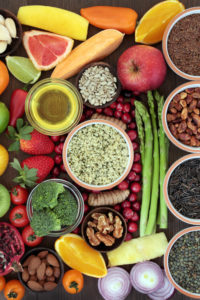Food Safety: How to Protect Yourself from Food-Borne Illnesses
Did you know there are more than 200 diseases that get spread through our food? Food safety deals with how you can avoid the spread of bacteria when you purchase, prepare, and store food. We should not take food safety lightly—the Centers for Disease Control and Prevention (CDC) estimates that 48 million people (1 in 6) get sick from food-borne illnesses in the United States every year. That begs the question: How safe is the food we eat? And what steps can we take to improve the safety of our food?
“The great majority of people will experience a food-borne disease at some point in their lives,” according to the World Health Organization (WHO). “This highlights the importance of making sure the food we eat is not contaminated with potentially harmful bacteria, parasites, viruses, toxins, and chemicals. Food can become contaminated at any point during production, distribution and preparation. Everyone along the production chain, from producer to consumer, has a role to play to ensure the food we eat does not cause diseases.”
Get Your Nutrition Guide
Do you want to eat foods that help you feel better, stay slim, and avoid diet-related diseases? Do you want to be healthier by eating delicious “super” foods?
If so, claim your FREE copy, right now, of the definitive nutrition guide on living a longer, healthier, happier life.
What Affects Food Safety?
When can food make you sick? Consuming food that has been contaminated by a disease-causing germ or chemical can lead to food poisoning. Food contamination can take place at virtually any stage of the food production process—from farm to plate. That’s why proper food hygiene is imperative during all stages of food production, including the stages of animal slaughter, harvesting, and processing.
Proper food hygiene is also a factor in the storage, distribution, and transportation of the food we eat. Safe food handling in grocery stores and restaurants (food service) is equally important. The environment (polluted water, air, or soil) can also put our food at risk. Since environmental factors and the food industry’s production processes are out of our control, we can only do what is within our control.
Follow These Simple Steps for Safer Food
The United States Department of Agriculture (USDA) advocates that the general public should take safe steps in food handling, cooking, and storage in order to prevent food-borne illness. They say we can’t always “see, smell, or taste harmful bacteria that may cause illness,” and that we should all follow the following four guidelines to keep our food safe:
Clean: Wash hands and surfaces often.
Separate: Don’t cross-contaminate.
Cook: Cook to proper temperatures, checking with a food thermometer.
Chill: Refrigerate promptly.
Here are more details about the USDA’s safe steps, as well as additional tips for safer food.
Make a Fresh Start
Food safety starts at your grocery store. Don’t take any chances in buying food that has expired and don’t purchase food that will expire before you want to use it. Place meat and seafood in plastic bags to prevent their juices from leaking onto other foods. Another great tip is to put frozen foods in your shopping cart last.
Cleanliness Is King
Sanitation is truly a first line of food safety defense; don’t underestimate its importance. Wash your hands, cooking surfaces, equipment, and produce (fruits and vegetables) before you prepare and cook your meals.
Cross Out Cross Contamination
Keep raw animal meats (including seafood) stored properly and separately in your freezer, and away from other foods during food prep because they can easily spread unwanted germs. Use separate knives, utensils, and cutting boards when working with raw meats.
Improve Your Food Storage Methods
Always cook your food thoroughly and properly. And then store your food at the correct temperature. There is a “danger zone” between 40 degrees Fahrenheit and 140 degrees Fahrenheit. This range is where harmful bacteria can multiply rapidly. To prevent illness, thaw out frozen foods—especially meats—in your fridge.
Many of us eat leftovers from the fridge long after we should (especially meat and seafood). It would be wise to find out whether that sloppy joe should actually go!
Consider freezing your leftovers more often than refrigerating them. FoodSafety.gov is an online resource maintained by several federal government agencies. The website has a free app available to the general public called the FoodKeeper App. You can use it online or as a mobile application for your mobile device. The app can help you understand how to properly store your food and beverages, and keep them at their freshest.
Check out these charts for specific temperatures required to cook and store a variety of foods safely. Some of the timelines may surprise you.
Follow Food Recalls
The USDA Food Safety and Inspection Service (FSIS) provides regular information and updates about food recalls to the public. You can keep up with the latest on food recalls by visiting their website and social media handles.
Ask Questions
If you have questions or concerns about any of the food you eat, contact food manufacturers and producers directly. Food recalls are currently not mandatory for food producers in the United States, which makes addressing food safety concerns even more serious. “Recalls are initiated by the manufacturer or distributor of the meat or poultry, sometimes at the request of FSIS,” according to the USDA. “All recalls are voluntary. However, if a company refuses to recall its products, then FSIS has the legal authority to detain and seize those products in commerce.”
The post Food Safety: How to Protect Yourself from Food-Borne Illnesses appeared first on University Health News.
Read Original Article: Food Safety: How to Protect Yourself from Food-Borne Illnesses »
Powered by WPeMatico


